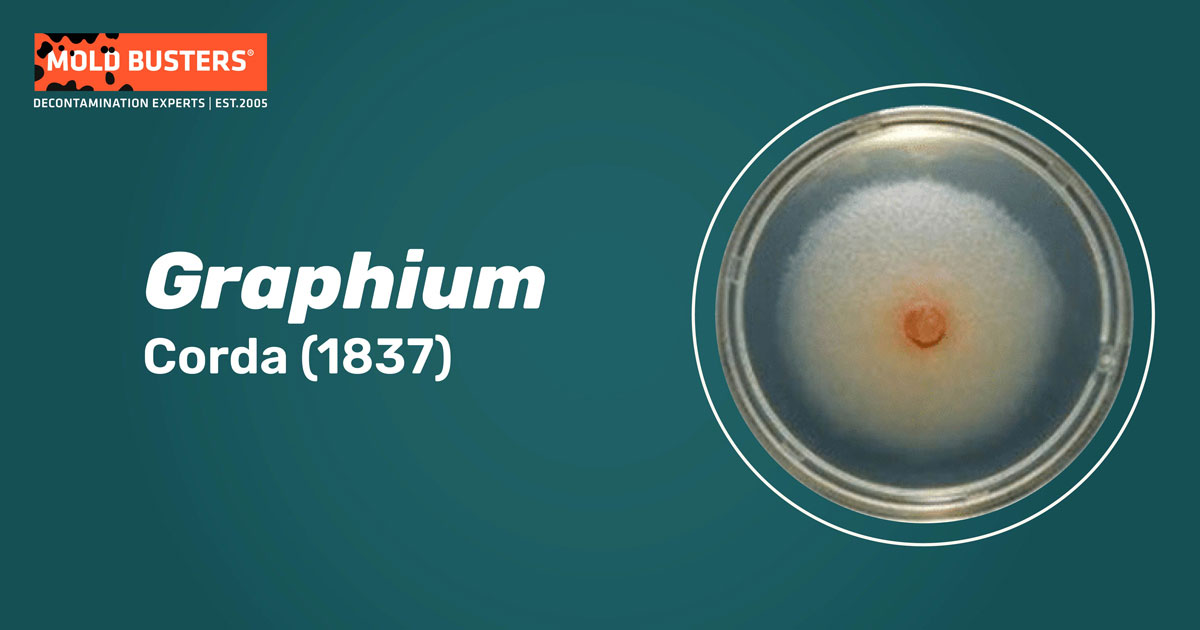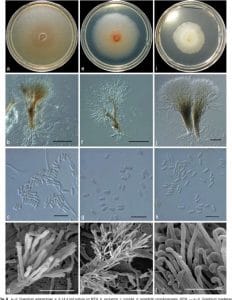Corda (1837)
What is Graphium?
Genus Graphium comprises species of asexual, filamentous fungi belonging to the family Microascaceae, class Sordariomycetes, and subclass Hypocreomycetidae [1]. Sexual states of Graphium species occur in Pseudallescheria and Petriella, while species such as G. basitruncatum don’t have a known sexual stage [2].

Where can Graphium be found?
Graphium spp. can be found in soil, plant material, and woody substrate [1, 3]. It is rarely isolated as a contaminant. However, some species of the genus are capable of infecting humans. These species (including sexual states) belong to the genera Petriella, Pseudallescheria, and Ceratocystis [1].
What does Graphium look like?
Graphium forms light to grey, wooly to cottony colonies that mature within seven days (Fig. 1). From the reverse, colonies are initially pale, becoming darker as they mature [1].

(Image source: Cruywagen, E. et al. (2010) [6])
Microscopically, hyphae of Graphium are septate, forming simple, long, dark-colored conidiophores. Erect conidiophores with conidiogenous cells form a bundle-like fruiting structure called a synnema (Fig. 1). Prominent, dark synnemata are the main characteristic of the genus Graphium. Synnemata are characterized by rhizoid-like structures at the base, and clusters of conidia formed at their tips, often resembling a developed tree. Conidia are single-celled, glass-like, oval (Fig. 1) and are produced in slimy masses [1, 4]. Graphium synnemata are rarely observed in culture, and their development can be enhanced on sporulation media such as oatmeal salts agar [2].
Some sexually reproducing fungi can have several types of asexual states, and these are called synanamorphs. For example, sexually reproducing Pseudallescheria boydii can have two types of anamorphic (sexual) states – Scedosporium apiospermum (scedosporium synanamorph) and Graphium eumorphum (Graphiumsynanamorph). Both synanamorphs do not always have to appear in an isolate. They can appear successfully at different stages, or both can be present, with one being located at the edges of a colony, as is sometimes observed in P. boydii [5].
What are health effects of Graphium?
The most clinically important isolates of Graphium belong to the genus Scedosporium, which includes its asexual stages [1,5]. Scedosporium apiospermum and Scedosporium prolificans are ubiquitous molds commonly found in soil, polluted waters, and sewage. They can cause a broad spectrum of clinical diseases, known as scedosporiosis, mostly in immunocompromised patients [5]. These fungi can colonize already damaged bronchia and lungs, particularly in cases of tuberculosis and cystic fibrosis [5]. The entry route is respiratory, and symptoms often include sinusitis, pneumonia, fever, cough, and coughing blood, followed by abnormal breathing sounds [5].
Infection can also follow the injury of skin and subcutaneous tissues, causing necrotic and ulcerated lesions. Infection can be localized or disseminated through the bloodstream to distant organs such as tendons, ligaments, bones, joints, the heart, or the brain [5]. Pseudallescheria boydii, the sexual stage of S. apiospermum, is also involved in infections. It can be recognized by the presence of a fruiting body (cleistothecia) [5].
Another clinically important species of Graphium is Graphium basitruncatum, reported as a causative agent of infections in immunocompromised patients [2, 3]. There has been one case of subcutaneous infection caused by this fungus in a heart transplant patient. The only symptom was a lesion in the palm since the patient didn’t have a fever or any sign of septicemia [3]. The other reported case of infection caused by Graphium basitruncatum was persistent fungemia (presence of fungal cells in the blood) in a patient with acute leukemia. Symptoms included fever and skin lesions on the patient’s extremities, and the outcome was fatal [2].
Diagnosis of Graphium species is traditionally based on culture and morphological characterization, while molecular tools are still investigational [5]. Clinical specimens can be obtained by biopsy of infected tissue, aspiration from sinuses, or blood samples. Graphium species can be successfully grown on routine laboratory media such as Sabouraud glucose agar, blood agar, and chocolate agar [3, 5], as well as on selective media such as modified Leonian agar that inhibits the growth of other filamentous fungi [5]. The incubation temperature is 25 °C to 35 °C (77 °F- 95°F) for all Scedosporium strains, while some of them can grow at 37°C (98.6 °F) or 42°C (107.6 °F) [5]. The reported incubation temperature for the cultivation of Graphium basitruncatum is 30°C (86 °F) to 37°C (98.6 °F) [3].
How to treat infections caused by Graphium species?
While infections caused by S. apiospermum (P. boydii) can be treated with antifungal triazoles, infections caused by S. prolificans rarely respond to medical therapy without surgery and immunotherapy [5]. Since only two cases of human infection with Graphium basitruncatum have been reported, there is no data referring to successful treatment.

Did you know?
Bathrooms in Canada are the most affected by the Basidiospores mold group?! Find out more exciting mold stats and facts inside our mold statistics page.
References
- Graphium Retreated from: drfungus.org
- Kumar, D. et al. (2007). Graphium basitruncatumFungemia in a Patient with Acute Leukemia. Journal od Clinical Microbiology. 45(5): 1644–1647.
- Fernández, A. L. et al. (2017). Subcutaneous infection by Graphium basitruncatum in a heart transplant patient. The Brazilian Journal of Infectious Diseases. 21 (6): 670-674
- Geldenhuis, M. M. et al. (2004). Identification and pathogenicity of Graphium and Pesotum species from machete wounds on Schizolobium parahybum in Ecuador. Fungal diversity 15: 137-151
- Cortez, K. J. (2008). Infections Caused by Scedosporium spp. Clinical Microbiology Review. 21 (1): 157-197
- Cruywagen, E. M., De Beer, Z. W., Roux, J., & Wingfield, M. J. (2010). Three new Graphium species from baobab trees in South Africa and Madagascar. Persoonia: Molecular Phylogeny and Evolution of Fungi, 25, 61.

Get Special Gift: Industry-Standard Mold Removal Guidelines
Download the industry-standard guidelines that Mold Busters use in their own mold removal services, including news, tips and special offers:

Written by:
Jelena Somborski
Mycologist
Mold Busters
Edited by:
Dusan Sadikovic
Mycologist – MSc, PhD
Mold Busters
